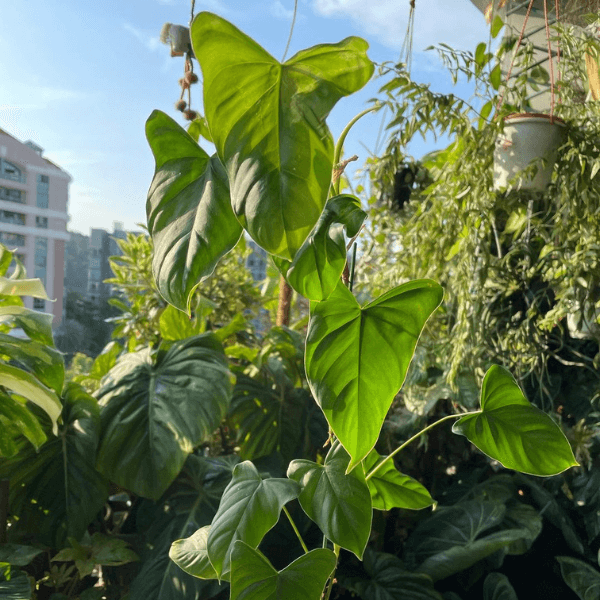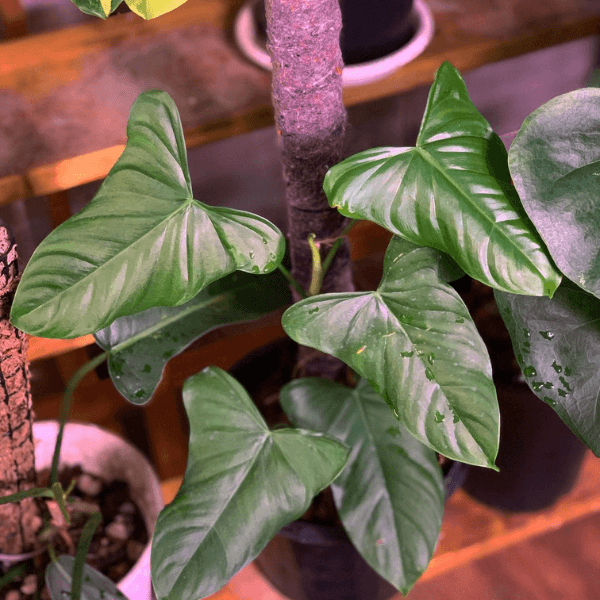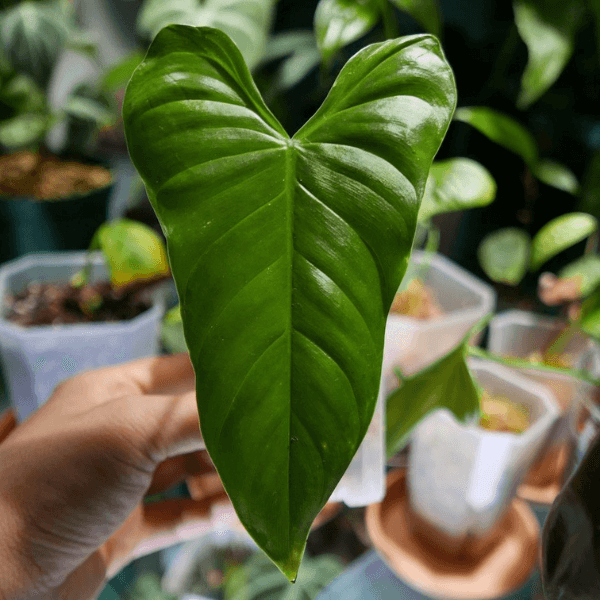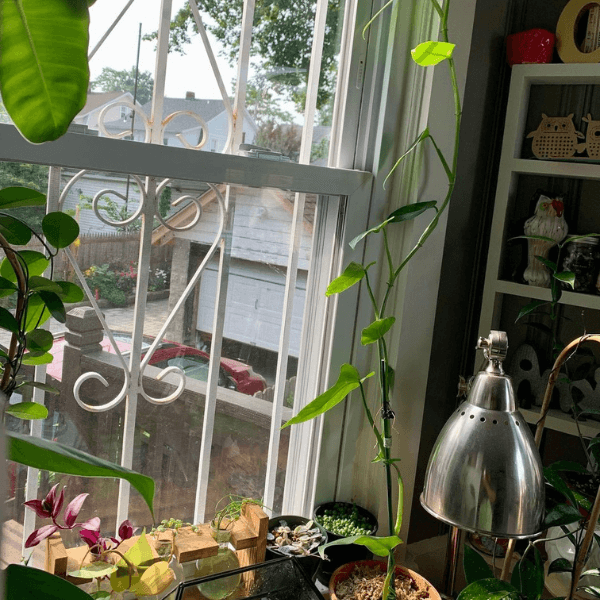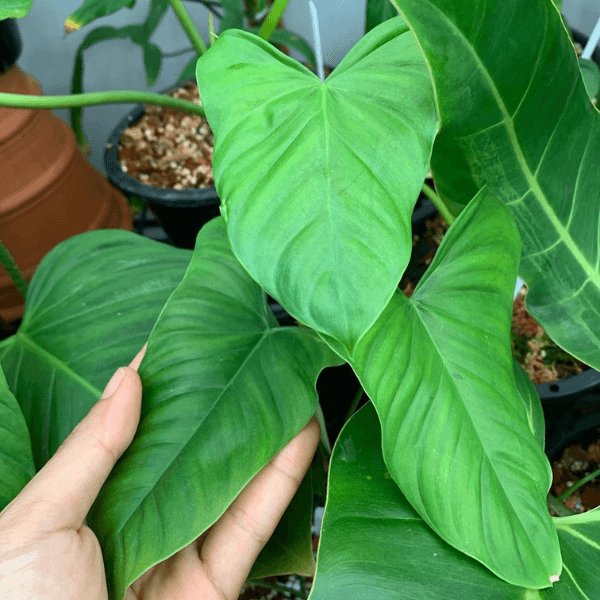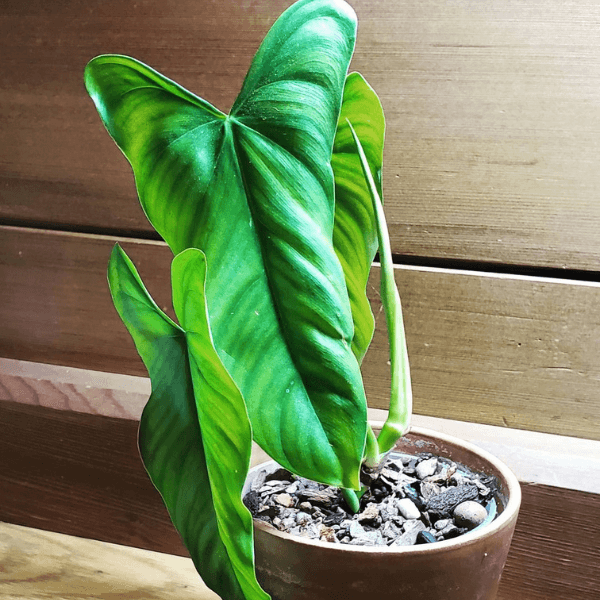Philodendron oxapampense is a gorgeous all-green tropical jungle plant that grows well indoors. Its leaves are deep green and shine brilliant green under brighter lighting. The shape of the leaves is particularly peculiar.
Juvenile leaves remind small arrows. Mature leaves become a significantly larger arrow-like shape. The shape of the leaf is somewhat reminiscent of the leaves of Philodendron atabapoense. They are easy to distinguish because the atabapoense leaves have a reddish colour underneath. The leaves of Philodendron oxapampense are green underneath.
Philodendron oxapampense is a climber by heart. A trellis or moss pole can be used to help it grow, and it can become a lush houseplant as long as you give it enough light.
Taking care of this gorgeous jungle plant is very easy. Therefore, it is suitable for both novice and experienced jungle plant enthusiasts.
Make sure you invest the time to learn about your philodendron. You will be rewarded with its thanks, and it will thrive under your care.
Philodendron oxapampense Care
How much light does it need? 🌤️
Ideally, the plant should be placed near the window. Indirect bright light is the best for philodendron oxapapense. Neither direct bright sunlight nor dim conditions will suit this plant well.
An indirect light-enhanced location promotes faster growth, larger leaves, denser growth, and better health in general.
When the conditions are too dim, the leaves are smaller, and the growth is slower. The plant may stretch out as it tries to reach the light. This results in huge gaps between the leaves. Consider using grow lights if you don’t have a brighter location for your plant.
The other way around, too much sunlight can burn its leaves. Leaves that have burned will be brownish, yellowish, or reddish and feel crisp to the touch. This damage occurs only on leaves exposed to intense sun. You can shade the sun with a curtain or other shade if you don’t have a place to hide from its rays.
How often do I need to water? 💦
The best time to water is when the soil is completely dried out. Feel the moisture level of the soil by poking your finger into it. If that is too rocket science for you, use a moisture meter, which tells you exactly your soil moisture level.
There is no exact formula for measuring watering density because it depends on how quickly your plant soil dries out. Several factors affect this, including the room temperature, pot type, etc. I recommend monitoring the soil moisture at least once a week.
When watering, water it thoroughly. Pouring small amounts on the soil frequently should be avoided. Plants can become overwatered if they are watered too often.
Philodendron oxapapense can be extremely sensitive to overwatering. An overwatered plant can develop root rot, which can be challenging to treat. Read more on how to treat and prevent a root rot. If you aren’t sure whether to water, remember that dry soil is better than wet soil.
Check the soil moisture beneath the pot from time to time by lifting the pot. By touching the soil near drainage holes, you can determine how moist it is. Under certain conditions, soil can dry quickly on top but remain highly wet underneath. Root rot can occur without you noticing it in this situation.
Philodendron oxapapense will show you if it’s thirsty by curling its leaves inside. If you see that symptom, water it immediately, and it will stretch its leave back to normal in a few hours.
You can try bottom-watering to minimize fuss. This technique requires a tray or container filled with water. Place the plant in water with its pot (which has drainage holes). Let the plant soak up water for 15-20 minutes. This way, Philodendron will take as much water as it needs, and you will not need to think about how many milliliters of water you need to pour on the plant.
It is necessary to occasionally water plants from the top if they are regularly watered from the bottom. Excess soil salts are removed in this way.
Don’t worry too much! Your oxapampense will likely survive first water failures. It is more important to learn from these situations to be more careful in the future.
Do I need to fertilize it? 💪
Short answer, yes. If your plant has active growth, eventually, it uses all the nutrients from the soil. I recommend fertilizing it from March to October. Give it a light break from fertilizing during the winter months.
You can use store-bought synthetic fertilizer. You can also choose organic or vegan fertilizer for your philodendron if you’re not into it. Both have needed elements for plants. Just select one specially made for green indoor plants or araid plants.
Read the instructions on the fertilizer if you are debating how much to put. Fertilizers can differ slightly in composition and need to be handled differently.
What is the ideal temperature and humidity? 🌡
For Philodendron oxapampense, the ideal temperature range is 65-85°F (18-29°C) during the day and 60-70°F (16-21°C) at night. While it prefers humidity levels of 60-80%, it can also thrive at levels of 40-60%. For plants to survive, humidity must be raised when it drops below 40%.
It is possible to take philodendrons outside during warmer months. You will have to take into account your local climate. You can bring the plant out and place it in the shade as soon as the weather warms up. Keep it away from direct sunlight. Ensure it’s indoors before it gets too cold or frosty.
The Philodendron oxapampense can be grown outside throughout the USDA hardiness zone 11. The following map highlights the USDA hardiness zone 11 with light orange color:
Which soil is best for philodendron oxapampense? 🟤
It will do its best in a well-draining and airly soil mixture. Plants in the aroid family can benefit from a potting mix made specifically for them.
Make your soil mix by mixing 50% regular potting mix with 25% perlite and 25% orchid bark. There is a lot of air and drainage in this mixture. According to experienced gardeners, arid houseplants benefit from bark drainage. Having it is not necessary if you don’t have it.
It is difficult for roots to survive in dense, heavy soil, and water cannot be absorbed. You should maintain your soil’s pH between 5-8.
What pot should I choose? 🪴
When it comes to pots, the material doesn’t matter. Don’t forget to make sure your pot has holes in it to allow for drainage. Drainage holes in the pot are designed to allow excess water in the soil near the roots to escape through them as quickly as possible.
I recommend placing a plastic plant pot inside the beauty pot. The plant is easier to manage this way. You should choose a beauty pot that you like, and that matches your interior.
When should I repot? 😳
When roots grow through drainage holes, it’s time to repot. The general recommendation is that plants should be replanted every two to three years.
Avoid planting it in a container that is too big. Philodendrons will have problems dealing with all the moisture and nutrients in that extra soil. The new pot should be 1-1,5 inches (2-4cm) more prominent than the old one.
Watch a video tutorial how to repot philodendron oxapampense:
How well does it tolerate pruning? ✂️
Philodendron oxapampense tolerates pruning quite well. You can easily cut it whenever it grows too tall or big, or you just want to make a new baby plant by cuttings.
Removing yellow, brown, and other unusually colored leaves is always a good idea. Plants look more beautiful with this, and they’ll focus more on healthy leaves. You can first try gently pulling colored leaves off, but if that doesn’t work, just carefully cut the leaves.
Please note! Always wear gardening gloves to protect your skin from the plant’s sap. To prevent the spread of any fungus or disease, I recommend wearing gloves and sterilizing your pruning tools.
Philodendron oxapampense propagation ☘️
Philodendron oxapampense is very easy to propagate. Taking cuttings is the easiest method.
Your checklist for propagation:
- Pot or a glass where cutting can root
- Pre-moistened soil-less medium (perlite, vermiculite, sand, sphagnum moss, or water)
- Sharp pruners or knife
- Rooting hormone (not necessary, but it has its benefits)
Fresh cuttings should be kept under indirect bright light. It is best to avoid dim lighting or too much sunlight. New roots and growth should appear in a few weeks. You know your propagation was successful as soon as new leaf growth appeared.
You can learn how to propagate Philodendron oxapampense by watching this video:
Philodendron oxapampense growth & size 🧐
Philodendron oxapampense is a reasonably fast-growing philodendron. It grows like a weed, according to some indoor gardeners. With just a single stem, it grows tall.
The plant can grow to 80 inches (2 meters) in height, and the leaves can reach 7 inches (20 cm) in length. To grow so tall, it needs extra support. Use growing trellis or moss poles. Poor growing conditions cause the plant’s growth to be slower and its leaves to be smaller.
Philodendron oxapampense flowers 🌸
There is something beautiful and rare about its white flowers. Spathe and spadix from the flower, as with most other aroids. A reddish spathe covers it. Botanically, it is called inflorescence. Philodendron oxapampense flowers very rarely in room conditions.
Philodendron oxapampense toxicity 😵
Pets and humans are toxic to Philodendron oxapampense. The leaves and stems of this plant are moderately toxic, and chewing them can cause mild symptoms.
It is believed that insoluble calcium oxalate crystals cause the symptoms. This plant releases crystals when chewed or bitten, causing tissue penetration and irritation in the mouth and GI tract. Upper airway swelling that makes breathing difficult is rare.
These are some signs to watch out for, according to the Pet Poison Helpline:
- Drooling
- Pawing at the mouth
- Oral pain
- Decreased appetite
- Vomiting
Lastly, philodendrons are not pet- or kid-friendly, so keep them up and out of reach of your pets and children.
To sum it up, philodendron oxapampense is a low-maintenance indoor plant with beautiful foliage. Once you know it, it will be easy peasy — an excellent addition to any jungle plant collection or a wonderful plant parent gift.
If you did not get the answer you were looking for, feel free to ask any additional questions you have in the comment section below. In any case, I will be happy to assist you.
Already a happy philodendron oxapampense parent? I’d love to see a picture of your plant! It would be great if you could share any advice or tips you’ve gained from your experience with this plant.
Let us know in the comments & let’s make this article even more helpful to readers like you.

